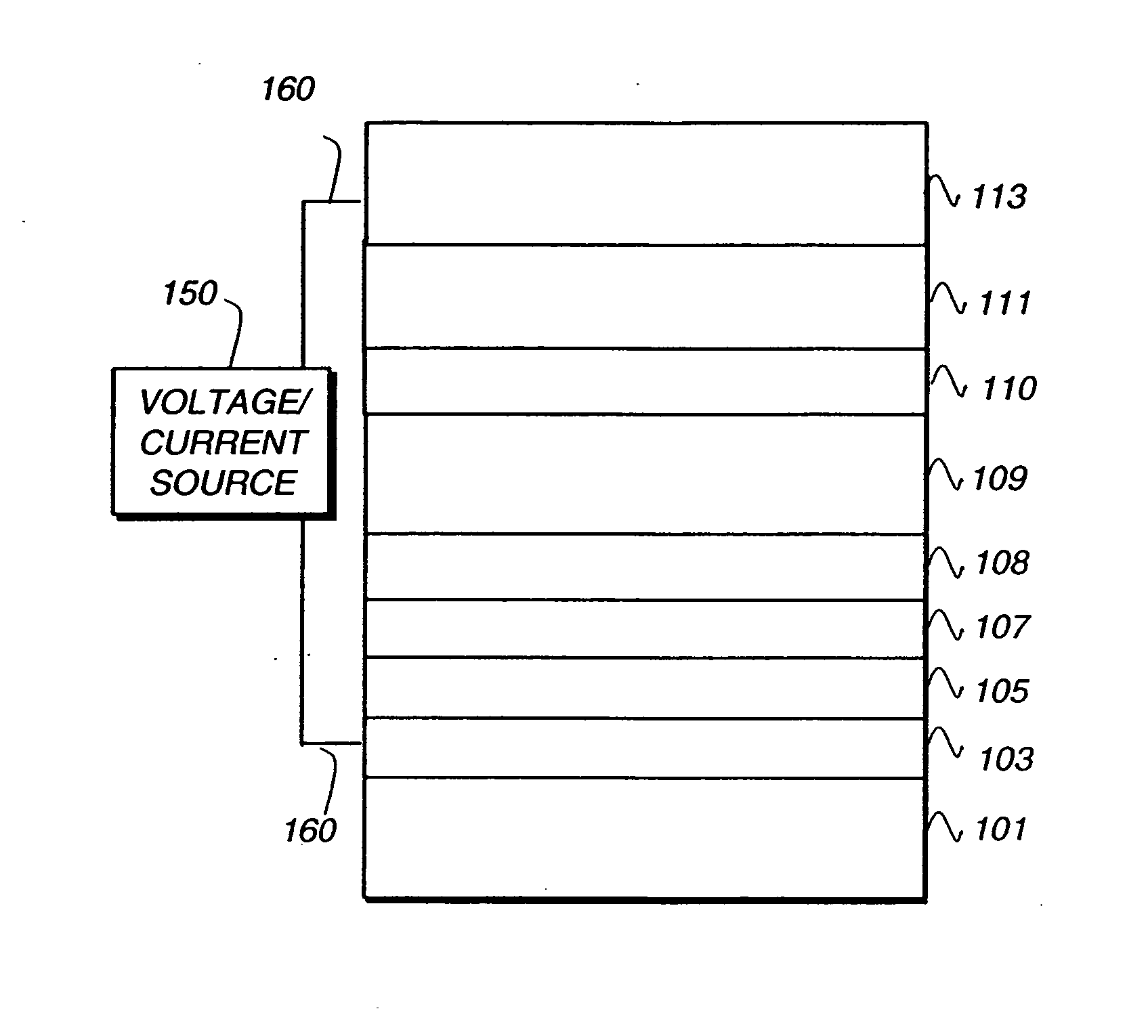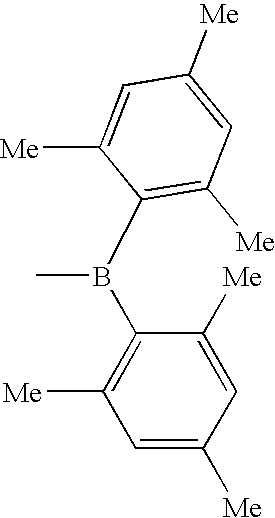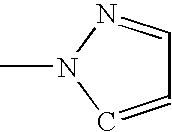Electroluminescent device
a technology of electroluminescent devices and light-emitting diodes, which is applied in the direction of discharge tube luminescnet screens, other domestic articles, natural mineral layered products, etc., can solve the problems of large loss of efficiency, and insufficient triplet energies of common host materials, such as cbp, to achieve efficient hosts. , good luminance and reduced drive voltage
- Summary
- Abstract
- Description
- Claims
- Application Information
AI Technical Summary
Benefits of technology
Problems solved by technology
Method used
Image
Examples
example 1
[0236] Synthesis of Inv-1.
[0237] Inv-1 was prepared by the following procedure (eq. 1 and eq. 2). A solution of 1,4-dibromobenzene (2.359 g, 10mmol) in ether (55 ml) was stirred at −40° C. under dry N2 and treated with a solution of butyllithium (2.5 M in hexane, 10 mmol). The resulting mixture was kept at −10° C. for 15 min, and then SiPh2Cl2 (0.93 ml, 4.5 mmol) was added quickly. The mixture was stirred at −10° C. for 30 min and at room temperature overnight. Then water was added, and the mixture was extracted with a combination of ether and dichloromethane. The combined extracts were washed with water, dried over MgSO4, and filtered. Volatiles were removed by evaporation under reduced pressure, and the residue was purified by column chromatography on silica gel with 7% toluene / hexane. This afforded bis(4-bromophenyl)diphenylsilane (Int-1) in 75% yield.
[0238] Bis(4-bromophenyl)diphenylsilane (3.2 g, 6.5 mmol) was dissolved in 40 ml dry THF. The solution was cooled to −78° C., a...
example 2
[0239] Synthesis of Inv-10.
[0240] Inv-10 was prepared by the following procedure (eq. 3 and eq. 4). A solution of 4-fluorobromobenzene (4.2 g, 24 mmol) in ether (55 ml) was stirred at −40° C. under dry N2 and treated with a solution of butyllithium (1.6 M in hexane, 20 mmol). The resulting mixture was kept at −40° C. for 30 min, and then SiPh2Cl2 (1.85 ml, 9 mmol) was added quickly. The mixture was stirred at −40° C. for 30 min and then at room temperature overnight. Volatiles were removed by evaporation under reduced pressure, and the residue was recrystallized from ether / methanol twice to give bis(4-difluorophenyl)diphenylsilane (Int-2) as colorless crystals; yield: 62%.
[0241] Sodium hydride (0.44 g, 11 mmol, in the form of a 60 wt % suspension in mineral oil) was added to a stirred solution of diphenylphosphineoxide (2.22 g, 11 mmol) in dry N,N′-dimethylformamide (40 ml) at room temperature under nitrogen. With evolution of hydrogen a yellow solution was formed. Then, bis(4-di...
example 3
Fabrication of EL Devices 1-1, 1-2, and 1-3.
[0242] EL device 1 -1, satisfying the requirements of the invention, was constructed in the following manner.
[0243] A glass substrate coated with an 21.5 nm layer of indium-tin oxide (ITO) as the anode was sequentially ultrasonicated in a commercial detergent, rinsed in deionized water, degreased in toluene vapor and exposed to oxygen plasma for about 1 min. [0244] a) Over the ITO was deposited a 1 nm fluorocarbon (CFx) hole-injecting layer (HIL) by plasma-assisted deposition of CHF3. [0245] b) A hole-transporting layer (HTL-1) of N,N′-di-1-naphthalenyl-N,N′-diphenyl-4,4′-diaminobiphenyl (NPB) having a thickness of 75 nm was then evaporated onto a). [0246] c) An exciton-blocking layer (EBL) of 4,4′,4″-tris(N-carbazolyl) triphenylamine (TCTA) having a thickness of 10 nm was then deposited. [0247] d) A 35 nm light-emitting layer (LEL) including a primary host, Inv-1; and 8% by volume of a phosphorescent light emitting material, D-1, was t...
PUM
| Property | Measurement | Unit |
|---|---|---|
| LUMO energy | aaaaa | aaaaa |
| LUMO energy | aaaaa | aaaaa |
| ionization potential | aaaaa | aaaaa |
Abstract
Description
Claims
Application Information
 Login to View More
Login to View More - R&D
- Intellectual Property
- Life Sciences
- Materials
- Tech Scout
- Unparalleled Data Quality
- Higher Quality Content
- 60% Fewer Hallucinations
Browse by: Latest US Patents, China's latest patents, Technical Efficacy Thesaurus, Application Domain, Technology Topic, Popular Technical Reports.
© 2025 PatSnap. All rights reserved.Legal|Privacy policy|Modern Slavery Act Transparency Statement|Sitemap|About US| Contact US: help@patsnap.com



